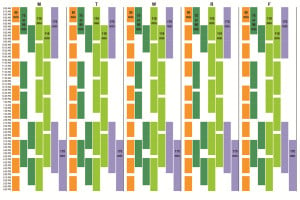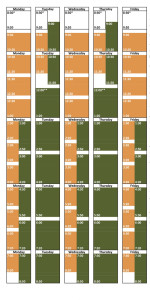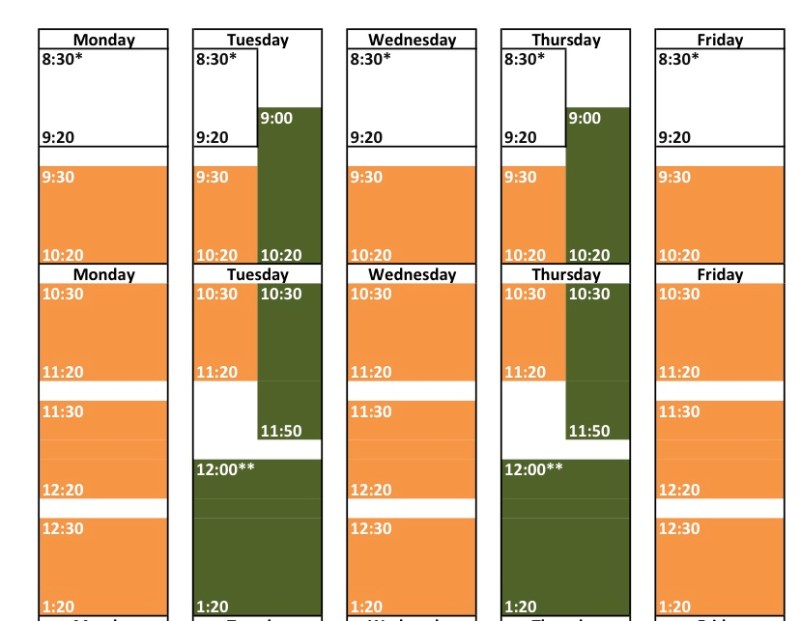The Office of the University Registrar has made changes and notations to its course-scheduling proposal addressing student concerns over 8:30 a.m. class start times.

The previous proposal arranged for classes to start on the half hour within a grid from 8:30 a.m. until 7:30 p.m. Monday through Friday. The revised proposal shifts hour-and-a-half long classes on Tuesday and Thursday down to 9 a.m. and includes a notation that 8:30 a.m. class times on Monday, Wednesday and Friday be typically reserved for labs, discussion sections and language classes that offer other meeting times.
Additionally, Stephen Shirreffs, associate university registrar, said that the registrar strongly advises departments not to schedule large undergraduate lectures at 8:30 a.m. While the registrar does not have the authority to restrict departments from pushing large lectures to the early morning, Shirreffs said there’s no movement from faculty toward such decisions.
The 8:30 a.m. option remains on the proposal because there are certain things, such as early morning discussion section options, that have to be scheduled early in the morning, Shirreffs explained.
“We believe that class days will actually start later for most people,” Shirreffs said.

He explained that under the latest proposal the vast majority of students taking hour-long classes would start no earlier than 9:30 a.m. and those taking hour-and-a-half-long classes no earlier than 9 a.m.
Ilya Mouzykantskii ‘16, chair of the Undergraduate Senate Communications Committee, and ASSU Executive Dan Ashton ‘14 had voiced student concern over the 8:30 a.m. start time and its effect on sleeping habits at an October Faculty Senate meeting.
While Mouzykantskii believes the registrar reached a consensus on starting classes later for two of the five days a week, the proposal still doesn’t go the full way toward what the ASSU was asking for—namely a 9 a.m. starting time across the board. He underscored that that the registrar cannot tell faculty when to schedule their classes, so the registrar’s office cannot guarantee that lectures will not start before 9 a.m.
“It’s half a win, and we’ll try to reach out to see whether the student body agrees with us,” Mouzykantskii said.
The revised proposal will be presented to the Committee for Undergraduate Standards and Policies (C-USP) at the end of the month and will then be presented at the Faculty Senate meeting in February for final approval. If approved, its implementation would be delayed until the 2015-16 academic school year.
“Had we gotten the approval at the beginning of this year, we thought we would have had enough time, but we feel like, especially given the large discussion that it’s created, we want to give everybody the opportunity to think it through,” Shirreffs said.
He added the Office of the University Registrar continues to speak with anyone that wants to discuss the proposal, though he believes all of the issues that students raised were answered.
The deans of the undergraduate and graduate schools commissioned a new scheduling grid in response to concerns coming from the Study on Undergraduate Education at Stanford University (SUES) report about inflexible scheduling patterns. The proposal for a new grid has been in discussion for the past two years, according to Shirreffs.
“Our current classroom meeting pattern is filled with structural conflicts that it’s actually highly inflexible,” Shirreffs said. “It looks flexible because there are many more choices, but the reality is, every time you make a choice with that pattern, you interfere with multiple patterns.”
The latest proposed grid allows faculty to stack up blocks of time that won’t cause as much interference with other classes if moved, given the fewer number of standardized start times.
Contact Ileana Najarro at inajarro ‘at’ stanford.edu.
